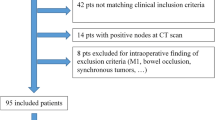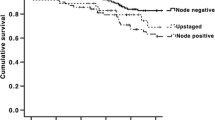Abstract
Objective
The aim of this study was to investigate the feasibility of sentinel lymph node biopsy (SLNB) in colorectal cancer.
Methods
Twenty patients of colorectal cancer were enrolled in this study. Endoscopic injection submucosally of 99mTc-DX was performed around the primary tumor 3 h before operation. Immediately after laparotomy, methylene blue was injected into subserosal layer adjacent to the tumor. Sentinel lymph nodes (SLNs) were defined as blue stained nodes or (and) those containing 10 times more radioactivity than surrounding tissue with a γ probe, all resected nodes were examined postoperatively by routine rapid frozen examination and HE stain. The diagnostic nodes metastasis states and false-negative rate of regional lymph node status on the basis of SLNs were calculated respectively.
Results
SLNs were detected in 16 of 20 patients with a successful detection rate of 80%, the number of SLNs ranged from 1 to 3, with a mean value of 2.4 per case, metastasis rate of SLNs were 37.5% (18/48), the diagnostic sensitivity was 80% (16/20), the diagnostic accuracy was 83.3% (15/18), the false-negative rate was 20% (4/20).
Conclusion
The SLN concept is validated in colorectal cancer. Combined-agent SLN mapping is an accurate diagnostic procedure for detecting lymph node metastasis in patients with colorectal cancer and may indicate rational extent of lymphadenectomy for colorectal cancer.
Similar content being viewed by others
References
Kretschmer L, Hilgers R, Mohrol M, et al. Patients with lymphatic metastasis of cutaneous malignant melanoma benefit from sentinel lymphonodectomy and early excision of their nodal disease. Eur J Cancer, 2004, 40: 212–218.
Nieweg OE, Bartelink H. Implication of lymphatic mapping for staging adjuvant treatment of patients with breast cancer. Eur J Cancer, 2004, 40: 179–181
Kitagawa Y, Fujii H, Mukai M, et al. The role of the sentinel lymph node in gastrointestinal cancer. Surg Clin North Am, 2000, 80: 1779–1809.
Veronesi U, Pagamelli G, Galimberti V, et al. Sentinel node biopsy to avoid axillary dissection in breast cancer with clinically negative lymph node. Lancet, 1997, 349: 1864–1867.
Blichik AJ, Giuliano A, Essner R, et al. Universal application of intraoperative lymphatic mapping and sentinel lymphadenectomy in solid neoplasms. Cancer J Sci Am, 1998, 4: 351–358.
Weaver DL, Krag DN, Ashikaga T, et al. Pathological analysis of sentinel and nonsentinel lymph nodes in breast carcinom: a multicenter study. Cancer, 2000, 88: 1099–1102.
Author information
Authors and Affiliations
Corresponding author
Rights and permissions
About this article
Cite this article
Li, H., Zhang, H., Yao, H. et al. Applied study of sentinel lymph node biopsy in colorectal cancer. Chin. -Ger. J. Clin. Oncol. 9, 158–160 (2010). https://doi.org/10.1007/s10330-010-0005-y
Received:
Revised:
Accepted:
Published:
Issue Date:
DOI: https://doi.org/10.1007/s10330-010-0005-y




